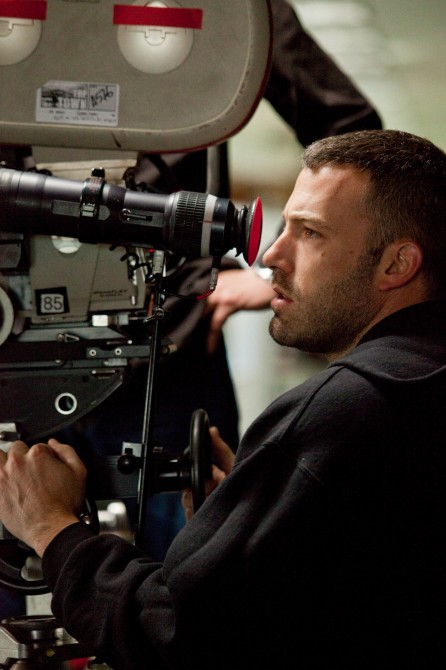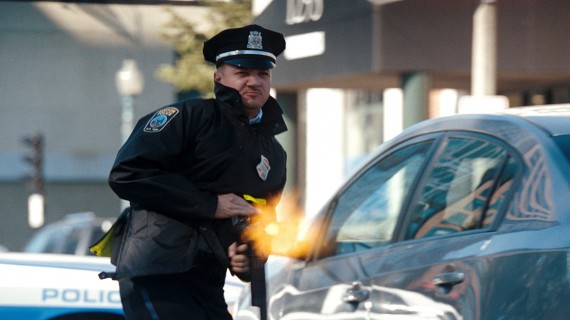Ben Affleck stayed firmly planted in Boston area after his freshman directorial effort, “Gone Baby Gone”. This time adapting author Chuck Hogan’s book “Prince of Thieves” about bank robbers in the Boston neighborhood of Charlestown with “The Town”. Sound supervisors Aaron Glascock and Curt Schulkey answer some questions about their time on the film below.
(Designing Sound) DS: Did Boston-raised Ben Affleck have any locale specific FX notes for you guys? Did he approach sound differently than other directors you’ve worked with?
(Curt Schulkey) CS: Ben Affleck made it very clear to us from the beginning that he wanted everything in the film to sound authentic to Boston. This meant using police and ambulance sirens native to Boston, local birds and BG’s, correct police radio jargon and appropriate references to streets and landmarks. He didn’t want any Hollywood BS.
We recorded the Group ADR in Boston- using SAG-approved locals to populate the bars, streets, restaurants, police radios- everything. The actors were a collection of people with very characteristic voices, accents and Boston vernacular – but none of them had ever done anything of this sort. Most of them picked it up pretty quickly. If you notice any background voices while watching the movie, they will all sound ‘Boston.’ We had the help of a Boston PD Lieutenant, a former Cambridge police chief, and several people who claimed to be ex-criminals or related to bank robbers. They were wonderful people to work with.
DS: What was the idea behind the sound or lack there of during the security-cam footage?
(Aaron Glascock) AG: That sound was built upon an idea by picture editor Dylan Tichnor. A sort of data stream presence, like timecode, what the electrons were watching and hearing.
CS: Also, going nearly silent allowed for a very startling contrast to the robbers blasting into the bank.
DS: What sounds did you chose to feature under Fenway Park while the crew realized “it’s too quiet”? When did you start pulling back on the BG’s and hard FX cueing Affleck’s interest in what’s going on around him?
AG: The distant skyline and diminishing reverb trails from the unseen gates causes Doug to sense something is wrong. While the gang is loading the money into the ambulance the chaotic activity heard in the prior walk-through dissipates exposing this unsettling silence. This moment ends with the reveal of the assembly of police outside.
CS: In the moments before it goes “too quiet” we purposefully filled the Fenway concourses with a lot of voices, which cleverly disappear as the robbers load their booty into their get-away ambulance.
 DS: Earlier in the film, there’s a great car chase through the streets of Boston’s North End. When prepping sounds for this scene, what characteristics did you look for in car, screeches, and impacts sound libraries? Did you record any specifics for this scene?
DS: Earlier in the film, there’s a great car chase through the streets of Boston’s North End. When prepping sounds for this scene, what characteristics did you look for in car, screeches, and impacts sound libraries? Did you record any specifics for this scene?
AG: The car chase was comprised of three chapters. Every element and how it performed needed to tell the tale with clarity within the context of the chapter. The get away car was established sounding tame, and eventually became quite rough and abused (and put out of its misery too). Initially the chase is about stepping on the gas and getting to point B – being “in” the car. Then it becomes about the obstacles, the physicality of it. Then about resources, will the car make it? One sound recorded specifically for this part was a valve train element used as the car is driven near the end of its life. A metal mechanism driven through the rpm range by a DC motor and controller served well for this. After making it to the switch car it becomes about time and racing the police to the bridge. This latter part being sonically comprised of grit and road surface, the texture of this chase – making room for music.
Throughout this sequence Ben was very sensitive to the over use of skids and sirens so our effort was to be distinct and not overbearing.CS: The characteristics of reverb were carefully done throughout the North-End chase. That area is a maze of horse-cart streets with lots of brick. In places where it would help (and not just add to the potential audio-overload) very specifically-created reverbs were used to give a feel of where we were. These are not blatant – I don’t think most people perceive the differences- but they’re there.
DS: In the dialog heavy scenes where the actors wore masks, how difficult were these scenes to cut and or match ADR?
CS: To be honest, the only part with masks that might be considered dialogue-heavy is the beginning of the first bank robbery, where everyone is wearing ‘Skeletor’ masks. They are hard to understand, but that’s how people wearing Skeletor masks sound. There was almost no ADR used in that scene. We did record some ADR, but very little of it was used, mostly some breaths and efforts, as Ben preferred the performances recorded ‘on the day.’
Matching was actually quite easy, as the production kept good track of the masks and provided them for the ADR sessions on request – so each actor had their original mask. Most of the ADR sounded nearly as bad as the production.
DS: Continuing on dialog, was there any extra DX editorial or ADR cueing necessary to address accents or clarify any Bostonian vernacular? Did the actors hold there accents throughout their performances?
CS: I don’t think we looped anything for accents except for Rebecca Hall. And even her replacements were more for vernacular than for accent – her American accent is very consistent and accurate. If we hadn’t replaced these couple of lines, I don’t think it would have been noticed by 98% of the audience.
Most of the real work on the dialogue in this film was restoration – trying to get the most out of what was recorded on the set. We sifted through all the different channels and all the different takes for nearly every line to be sure we had the best possible version of the performance that the director preferred. We did a great deal of audio repair on those tracks to remove undesired sonic debris. Radio static, mike bumps, ticks, pops, OSHA beeps, sirens, car alarms, bird squawks, people on the street yelling when they saw Affleck. There is one long scene in the Public Gardens where Doug (Ben Affleck) describes an event from his childhood. There was a single cricket chirping through every take of every angle on Ben. I spent hours removing every chirp because it was distracting from the performance. Sometimes we were simply removing the sticky ticks in the middle of words that become prominent when actors speak at a low volume. But by doing so, it was possible to play them louder without those ticks becoming awful. We did restoration to every scene, and I’m very happy with the results. ADR is very minimal.
DS: How did you cast the gun sounds for the film? Was authenticity a concern in finding the right sound?
AG: The guns heard were either the full load production track guns (extensively reworked) or were combined with select channels from a 16 track series of guns of the same caliber and make. There’s an OSHA paper on automatic weapons (for military use), I think on average the guns used in this movie were documented in this paper at about 130-145 db. Obviously, we cannot reproduce that for an audience. Ben’s first sound directive to us was to convey the severity and power of these automatic weapons, He wanted the audience to be “next to” the guns as depicted. Having the guns dictate the very primal sensation that the shooter experiences and not relying on volume alone was the design challenge – The guns needed to be encoded with fear.
In real life very loud sound causes one’s ears to collapse. The resulting cocktail of adrenalin and numbing of directional and proximity senses, becomes disorienting, and as this continues, our brains chemically instruct our bodies, there’s danger – run for your life!. So in addition to sculpted reverb’s we used a gun element derived from these tracks that was very mono in the surrounds, very blocky sounding, momentarily neutralizing any directional information, and was effective in this manner.
DS: How did you deal with the perspective changes in the final firefight? (interior vs. exterior) How did you guys cover the off screen gunfire?
AG: The perceived sense of geography was very important for this sequence. The sound had to sell the locality of the action. Virtually predubbing as they were edited the multi-channel guns were leveled shot-to-shot, balancing for each changing perspective. The reverb tracks were rendered from pitched and delay-cycled reverb blooms. The guns and related elements were rendered on the pre dub stage. During the final it was determined that it would be more dramatic if there were more pauses so we spent some time cutting the predubs. This increased the gaps between fire and made room for the blooms which became a major component of this scene.

Excellent film and great sound work. Congrats to all involved!